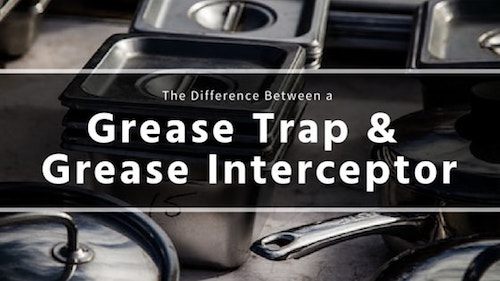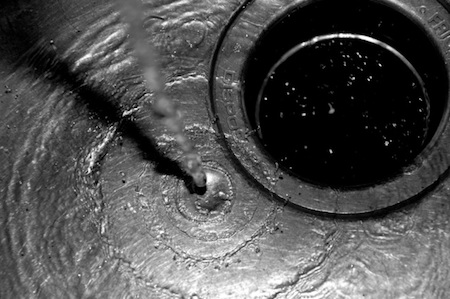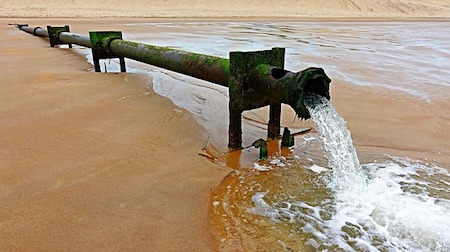
If you are in the process of setting up a commercial kitchen, one thing is certain: you need either a grease trap or a grease interceptor.
Essentially, these two devices work by preventing fats, oils, and grease (FOG) from interfering with other parts of a restaurant’s plumbing. There are some key differences between grease traps and grease interceptors when used for grease management and grease removal. A large-size grease trap would also need cleaning less often than a smaller one or a grease interceptor.
Grease Traps vs. Grease Interceptors
Grease Traps
According to the Uniform Plumbing Code (UPS), traps are used for low-flow situations. That is, they are designed specifically to work with low water pressure (less than 50 gallons per minute). This is how grease traps work.
Usually, restaurants have under the sink grease traps set up in their kitchen. Traps vary greatly in terms of size. Their size can be that of a small box or as big as a mini-fridge. This a key difference between grease traps and grease interceptors.
For optimum efficiency and no foul odors, a grease trap requires regular maintenance. That means, regularly emptying and grease trap cleaning. Of course, the frequency depends on the specific needs of your food establishment. The way a grease trap works is by collecting grease, but you still need to clean it.
Grease Interceptors
According to the UPS, a grease interceptor is designed for kitchens that have a flow rate of more than 50 gallons per minute. As such, grease interceptors are ideal for installation in large restaurants where there is a lot of grease flowing through the drains.
This is how grease interceptors works differently than a grease trap and help wastewater flow out into the septic system.
Unlike grease traps, grease interceptors aren’t installed below the kitchen sink. Due to their size, they are usually installed underground and outside of the building. This is how grease interceptors works.
Benefits of Using a Grease Trap or Grease Interceptor
- Economically speaking, many grease traps are made of stainless steel. This allows them to be durable and long lasting when you’re considering a grease trap or grease interceptor.
- Maintaining the life of your septic tank is important. A grease trap or grease interceptor is a significant piece of equipment to keep your septic tank system efficient.
- Helps improve your business’ public image. Having a grease trap is actually a selling point your business can use to show they are helping the environment as opposed to a grease interceptor.
- A grease trap’s ultimate advantage to your business is eliminating backflows. Avoiding this issue can save you time and money.
- Grease traps are environmentally friendly. By preventing the release of FOG into local rivers and streams, you’ll be doing your bit to keep the environment clean.

How Often do Grease Traps and Grease Interceptors Require Cleaning?
Regular maintenance and servicing allow these devices to do their job efficiently. If you own a food establishment, it is likely that you are well aware of how a grease trap or a grease interceptor works.
As a matter of fact, state regulations require this. This is important for maintaining a healthy and safe environment whether you have a trap or grease interceptor where wastewater flows into the septic system.
Generally speaking, grease traps require more cleaning than grease interceptors. The reason? They are smaller and therefore tend to fill up rather quickly. Most grease traps will require cleaning at least once a month.
Grease interceptors, on the other hand, are bigger and will take some time to fill up. In general, grease interceptors should be cleaned out at least once every three months.
Another good indicator of when a grease trap or interceptor should be cleaned out is the ¼ rule.

Using the 1/4 Rule
A good rule of thumb for any cleaning schedule is anywhere between one and three months. But, to specifically determine your needs, you’ll need to follow the ¼ rule.
The ¼ rule is an internationally recognized standard that states that once ¼ of your grease trap has been filled with FOG, it requires to be pumped out.
Why ¼? After that much FOG has been trapped, the device no longer becomes effective.
Worse, there is a high risk of increased blockages and overflows. If you notice that you reach the ¼ of your grease trap faster than usual, consider sizing up as grease trap cleaning can only do so much. Blockages can also be bad for the sewage system, and a good sewage system is important not just for your restaurant but for the city.
Pay Attention to County Ordinances
Thinking about why you need a kitchen grease trap or interceptor in the first place? Well, state and local ordinances require it. They have a vested interest in keeping blockages of the sewer system clear and water treatment flowing since they manage the local water systems and treatment plants.
Grease trap laws vary by city, town, or county. As such, make sure your establishment is up to code depending on its location. Failure to follow these laws and regulations may attract fines or even closure of your business due to the blockage of the sanitary sewer system.

Grease Trap/Interceptor Cleaning and Pumping Tips
- Clean your grease traps before or after business hours to ensure the unpleasant odor doesn’t affect patrons.
- Clean grease trap interceptors that have a capacity of 100 gallons or less on a weekly basis in between pump outs.
- Recycle waste cooking oil so it doesn’t end up in your grease trap, causing the need for frequent pump outs.
- Scrape plates and utensils of any excess food or debris before washing to limit the amount of FOG making its way to your trap.
Grease traps and grease interceptors are an essential part of a properly functioning commercial kitchen. They help prevent FOG from entering your sewer line. If you need your grease trap or interceptor repaired or cleaned, call [919-817-6792](tel: 919-817-6792) today.




